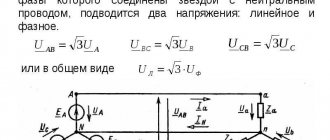What is high voltage?
In any electrical network, be it household, industrial or high-voltage, there is a set level - 220V, 380V, 6 - 10 kV and others. These parameters must be within strictly established limits, not exceeding 5% of the norm for a long time and 10% for a short time. But in practice, there are situations when high voltage in the network may occur, exceeding the nominal value by 20%, 30% or more. Which creates a threat to electrical devices and humans in the event of a device breakdown and potential transfer to their housing. The reason for this increase may be various processes in the network.
Causes
In practice, both low and high voltage in the network have a number of negative consequences for household electrical appliances. Regardless of the level of the rated voltage in the network, an increase can occur for the following reasons:
- Artificial adjustment of the output level using an on-load tap-changer or tap-changer at a substation or package transformer substation. Due to frequent complaints about low voltage, the power supply organization increases the output parameter. As a result, in the last house connected to the line, the input voltage will correspond to the norm, and in the first it will significantly exceed.
- In addition, high voltage occurs during seasonal changes, the transition from day to night, changes in operating cycles of powerful equipment, etc. When the amount of electrical energy consumed differs significantly at the peak of the cycles. For example, in winter or before the start of centralized heating, household electrical networks suffer from numerous heating devices that cause low voltage. If at the same time the adjustment is made upward, then with warming a fairly large potential will arise on the transformer windings.
- Phase imbalance is caused by both damage to the network (for example, a break in the neutral wire) and a significant difference in the connected power to each line. At the same time, in some of the phases the alternating current increases and the voltage decreases, and in the neighboring phases, on the contrary, high voltage appears.
Rice. 1. phase imbalance - Emergency situation - due to damage in the networks, for example, a phase falling to zero, the potential difference will increase to a linear level. That is, instead of 220 V, 380 V will be supplied to household appliances. An identically high voltage can occur when the insulation breaks down between the high and low sides, when one of the phases breaks and zero-sequence currents occur.
Consequences
As a result of the occurrence of high voltage beyond permissible fluctuations, all kinds of household, power and electronic devices experience significant overload. This can cause various problems in their operation. Among the most significant consequences are:
- Failure - if the potential increases above 250 V, electronic units and microcircuits of various devices may burn out.
- Increase in current and overheating - when the voltage fluctuates upward with the same section resistance, the rated current increases proportionally. This causes excessive heating of the conductors and can lead to a fire. This consequence is especially dangerous for all lighting devices.
- Violation of normal operation is typical for electrical machines and high-precision devices, the operation of which is regulated by strict adherence to the parameters of the electricity consumed.
- Reduced service life - due to an increase in potential difference and overheating, premature aging of the insulation occurs, which leads to breakdown or failure of some functions.
It should be noted that most expensive modern devices are equipped with indicators for voltage drops, current surges and other deviations beyond acceptable limits. Because of this, if such devices fail due to high voltage, the manufacturer has every right to refuse its own warranty obligations. Therefore, to prevent financial waste on restoration from such impacts, measures should be taken to bring the network parameters back to normal.
High Voltage Hazard
Power outages have serious consequences:
- Reduced service life of devices. The technique reacts painfully to changes in the voltage value. If the increase lasts more than 15 minutes, the adapters overheat and break. Lighting equipment is the most sensitive to vibrations.
- Malfunctions. Each electrical appliance operates within certain limits established by the manufacturer. When the values exceed the permissible values, the equipment begins to operate abnormally.
- Breakdowns. If the voltage rises to 255 V or higher, any equipment can fail.
- Impossibility of warranty service. If an electrical appliance malfunctions under warranty, the technician at the service center will easily determine that the cause of the breakdown is a power surge. In this case, repair, exchange or return of the goods will be refused.
- Increased current and overheating. As a result of strong heating, contact connections are damaged, insulation melts, and wires burn. All this can lead to ignition and fire.
Measures to normalize the voltage level in the network
Depending on the location of the impact, measures aimed at combating high voltage can be general, affecting the entire network, and local, applied to a specific consumer. Please note that for local measures, for example, at home or in an emergency, there is no need to coordinate the installation of the stabilizer with the electricity supplier. While general measures require contacting certain authorities.
Where to complain to solve the problem?
If the mains voltage is high, you can submit a corresponding request to the regulatory authorities to take action. This could be local city or village councils or the electricity supply organization directly. The first option is the most effective, since their function is to control the operation of the same RES. But due to the large number of transmission links, contacting local authorities is a lengthy procedure.
To contact the power supply organization, you need to not only report high voltage at your own connection, but also inquire about this parameter from neighboring consumers. Since if others are satisfied with the level, or one of them complains about low voltage, then they will definitely not lower it further.
As a rule, the Distribution Zone is in no hurry to respond to single requests that consider the interests of one consumer, but can affect the three-phase current for the entire group or area. Moreover, before this they could already make adjustments at the request of other persons. Therefore, in such cases, the fastest option to combat high potential differences is to install stabilizers and other protective devices.
How to reduce high voltage at home?
If you cannot influence the voltage level through a written request or it simply does not give the desired result, then it is necessary to install protection devices. Among the most common options are:
- Surge filter – allows you to eliminate short-term surge voltages. It is divided into several categories, depending on the complexity of the device and the specific operation of the protected object. Its disadvantage is the inability to eliminate long-term overvoltage in the network.
- Voltage regulator – allows you to change the value of high or low voltage at the input to the nominal value. This ensures not only ideal power supply to the consumer, but also its protection from emergency conditions - surges in electric current due to atmospheric overvoltages, short circuits, etc.
Figure 2: Normalization using stabilizer - Voltage control relay - disconnects all devices from the network in which low or high voltage has crossed the permissible deviation level. The natural drawback of the device is that it does not solve the problem of long-term increase in potential. And after switching the relay, you need to turn it back on yourself.
When installing automation that independently cuts off power in the event of overvoltage detection, uninterruptible power supplies can be used to restore power supply. Which will continue to power the equipment until the potential in the network normalizes.
Rice. 3. Example of turning on an uninterruptible power supply
Complaint about changes
The supply of electrical energy to consumers that does not meet the requirements of the standards becomes the basis for filing a complaint about power surges.
Causes
The reason for complaint is the supply of electricity of inadequate quality (with low or high voltage, its drops and surges). This often leads to damage to household appliances and even fires, which poses a threat to people's lives and health.
What do power surges lead to, using the example of Sochi residents:
Household appliances have broken down: what to do?
If voltage surges lead to the failure of household appliances (refrigerator, washing machine, oven, microwave oven, computer, TV, etc.), you must follow these steps:
- try to at least visually clarify the cause of the breakdown, and if there is a suspicion of a connection with surges, move on to the next point (the fact that there is a relationship is indicated, for example, by the extinction of the light, a sharp sound from the device immediately before the breakdown);
- call the emergency service and invite representatives to draw up supporting documents;
- assess the damage caused (usually by contacting specialized institutions, such as repair shops);
- draw up a claim for damages and send it to the culprit (electricity supplier);
- if the damage caused is not compensated, then it is necessary to prepare a statement of claim to the court (submitted at the plaintiff’s place of residence and is not subject to state duty).
All documents collected during the above steps before going to court must be attached in copies to the claim.
To protect yourself from unpleasant situations with horse racing, you need to quickly respond to the delivery of low-quality services by filing complaints. You can also use special devices - uninterruptible power supplies and stabilizers.
Rice. 2. Voltage stabilizer
What to write in a complaint
Table 2. What to write in a complaint
| Short description | |
| Recipient | Name of the authority where it is addressed |
| Applicant (representative) | Personal details, address and telephone number, if available - email |
| Title of the document | Complaint (claim) |
| The essence | Briefly describe the reason for your request |
| Requirement | What is the applicant asking for? |
| Application | Additional materials (acts, photographs, certificates) |
| Date and signature | At the end of the claim, the claim is made by the applicant or representative |
Attention! In order to detect the failure of household appliances, it is necessary to call the emergency service. Be sure to keep a copy of the completed act for yourself
You can use the sample below to file a claim.
complaints about power surges
Where to contact
The complaint can be sent to:
- management organization (residents of apartment buildings);
- resource supply company (residents of the private sector and apartment buildings);
- Department of Housing and Communal Services, Housing Inspectorate;
- Rospotrebnadzor;
- prosecutor's office
If all of the above authorities do not solve the applicant’s problem or he suffered harm (for example, a TV set burned down), which the culprit refuses to compensate, then he has the right to file a lawsuit. In this case, it is necessary to attach all the collected materials: copies of claims, responses to them, an act, a certificate from a repair shop, etc. When there are several victims during a certain period (for example, residents of the same entrance), you can draw up a general statement of claim.
Ways to complain
You can complain:
- orally (for example, by first calling the management organization or electricity supplier);
- in writing (by sending a claim by registered mail);
- through the Internet.
Sometimes the solution to a problem can happen after a phone call. But more often a written claim or an appeal via the Internet is necessary.
Typical frequently asked questions from readers
I connected the LIEBHERR {CUN3033} refrigerator via a PH-122 voltage relay. For about a week everything was fine, the network voltage was within the upper limit, the factory setting was 250 volts, and the refrigerator was working. But from December 31 to this day, the relay shows 250-253 volts and the refrigerator is turned off for approximately 5 hours a day. And at night I don’t even know how it works. Please tell me, is it possible to set the upper limit on the relay to 255 volts or is this unacceptable for a refrigerator? Could the relay be faulty? And why is there such high voltage in the network in an apartment in Moscow, or is this the norm? Please advise what to do? And also, the relay gets warm, a little, but the body is warm, is this normal or not?
As I understand it, you installed the RN-122 voltage control relay in the plug socket for connecting the refrigerator. There are many questions, but let's consider everything in order. If we consider the permissible response limits, then, in accordance with the passport data, the regulation range for Umax is from 230 to 290 V. Therefore, yes, you can set the maximum voltage limit to more than 250 V.
The fact that you have set the maximum limit Umax to 250 V indicates that you are using the factory settings (for the RN-122 voltage control relay, the minimum voltage response threshold is 185 V, and the maximum voltage is 250 V). To change the value of the maximum response threshold, you need to perform the following steps (see the figure on the link):
Regarding the rated voltage, in accordance with GOST 32144-2013, the maximum limit is 253 V (that is, +10% to 230 V). But for many household appliances this is too much. I recommend that you double-check it with a multimeter or voltmeter; if this is indeed the case, contact the management company with an official statement. Otherwise, the relay may actually be faulty and simply needs to be replaced.
What should an energy consumer do?
The simplest way to protect against power surges is to turn off devices in a critical situation. Such devices are based on voltage control relays of the RN type and electronic control circuits. If there is an excessive drop in the network, household appliances turn off, and when they return to a stable state, they automatically turn on again.
Such devices are mounted directly at the entrance to the electrical appliance. With their help, most often, long-term operating devices (refrigerators, washing machines, etc.) are protected. If there are frequent and long-term fluctuations in the network, care must be taken to continuously maintain its parameters within normal limits. For these purposes, special devices are used - voltage stabilizers.
If the fluctuation occurs within the operating range, then the device constantly maintains the voltage at the nominal value (220 V) with a deviation of no more than 1-2%. When jumps exceed the permissible values, the device turns off and turns on again when returning to operating limits. Modern stabilizers have an operating range of about 160-250 V.
If voltage drops are caused by internal reasons (for example, poor quality wiring), then you need to call a professional electrician to correct the situation. He will find the reasons and eliminate the malfunctions. It’s another matter when there are network disturbances and a voltage that does not meet GOST requirements is supplied to the apartment’s input. If such cases are recorded frequently, then you should exercise your right as a consumer of the service.
Where to complain?
If you have a complaint about the quality of power supply, you can contact:
- management company;
- territorial power grid company;
- municipal housing and communal services department;
- Housing inspection;
- Rospotrebnadzor.
You can complain by visiting the organization in person, by letter or via email. Procedure:
- submitting an application to the organization servicing the house and calling an electrician;
- drawing up a report on deviations from the norm by an electrician;
- submitting an application with a report attached to the management company with a request to rectify the situation;
- if refused, send a complaint (claim) to the supervisory authority.
How to file a complaint?
If the tenant refuses to eliminate the violations, he has the right to file a complaint with any of the above authorities. The basis for its design is the Law “On the Protection of Consumer Rights”, Decree of the Government of the Russian Federation dated 05/06/2011 No. 354 and GOST 32144-2013, which establishes electricity quality standards. The complaint is submitted in writing in free style. Some points are mandatory:
- Name of the organization and full name of the person to whom the claim is being written.
- Full name, passport details and address of the person filing the complaint.
- Reasons for appeal and complaints with references to the legislation of the Russian Federation.
- Finally, you need to describe your requirements.
- Add date and signature.
It is important to clearly indicate the violations identified. The following claims can be considered justified:
The following claims can be considered justified:
- excessively low or high voltage;
- long periods of unstable voltage and its complete loss;
- signal frequency deviation from the norm;
- the appearance of impulse voltage.
The consumer has the right to make the following demands:
- Tariff reduction by 0.15% for each hour of supply of electricity of inadequate quality (Resolution No. 354).
- Compensation for losses in the event of failure of household appliances due to a sudden power surge.
The complaint is accompanied by an act of violations, a report or a certificate from the repair shop about the failure of the equipment.
complaints about low voltage in the electrical network complaints about low voltage in the electrical network We do not recommend completing the documents yourself. Save time - contact our lawyers by phone:











